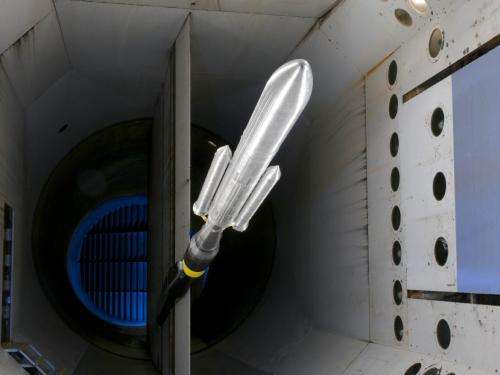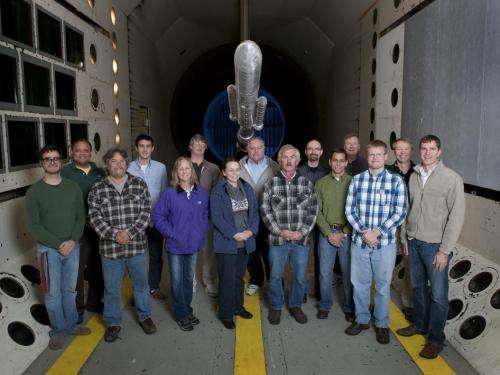SLS model 'flies' through Langley wind tunnel testing

(Phys.org)—At NASA facilities around the country, engineers are developing America's first exploration-class rocket since the Saturn V launched astronauts to the moon. The Space Launch System (SLS) will provide an entirely new capability for science and human exploration beyond Earth's orbit to destinations such as an asteroid and eventually Mars. To enable some of these new capabilities, members of the Aeroelasticity Branch of NASA's Langley Research Center in Hampton, Va. tested a ten-foot-long buffet model of the Space Launch System in Langley's Transonic Dynamics Tunnel (TDT).
"This is a critical milestone for the design of the vehicle," said Langley research engineer, Dave Piatak.
Data retrieved will help prepare SLS for its first mission in 2017, Exploration Mission-1 (EM-1), which will deliver an uncrewed Orion spacecraft to lunar orbit to check out the vehicle's systems.
But before SLS's first flight, the safety vehicle must be demonstrated through analysis and testing. An important step in ensuring a safe flight to orbit is buffet wind-tunnel testing to help determine launch vehicle structural margins.
To do this, a wind-tunnel model is put through its paces at transonic and low supersonic speeds reaching up to Mach 1.2. Testing aerodynamics at these speeds is essential to understanding the structural interaction to the flow field around the vehicle and determining loads on the flight vehicle.
"The test includes the largest integrated vehicle model to be tested in a wind tunnel for SLS," John Blevins, SLS Lead Engineer for Aerodynamics and Acoustics. "It will simulate the environment of transonic flight that the SLS rocket will navigate during its flight. The Transonic Dynamics Tunnel at Langley affords a unique simulation capability among national facilities."

The amount of data acquired from the SLS model is enormous. To be exact, 360 miniature unsteady pressure transducers on the model's surface are measured using a data acquisition system scanning at thirteen thousand scans-per-second.
That's a lot of scans.
These transducers are like tiny microphones, which allow engineers to measure the unsteady flow that exposes the vehicle to rapidly changing forces during its flight through the atmosphere.
Unlike the rigid SLS buffet wind-tunnel model, the real launch vehicle is quite flexible.
The rocket will bend and shake in response to forces during flight, and engineers use tests like this to determine that the resulting bending loads and vibrations are within the launch vehicle's safe limits.
They will use the data from this test to determine the structural safety margins of the vehicle. Buffet forces measured during wind-tunnel testing will be applied to a computational structural model of the launch vehicle to determine what kind of bending forces and accelerations the vehicle can handle.
"A structural dynamic analysis will predict the response of the launch vehicle due to dynamic events such as liftoff, buffet, wind gusts at high altitudes, staging, and engine start up and shut down," Piatak explained. "It is an important process for ensuring a safe flight for not only the launch vehicle but also any payload that it carries to orbit."
Once the data is retrieved and analyzed, NASA's engineers can refine the design of the SLS vehicle using the buffet model before the full-size rocket is built for flight tests.
After completing EM-1, SLS will perform its second mission in 2021, Exploration Mission-2, launching Orion with its first crew of astronauts to demonstrate orbit around the moon.
"This is the greatest job," Piatak said. "To be working on rockets that will launch the next era of exploration is very exciting and the stuff of children's dreams. I can't wait to see this fly."
Provided by NASA




















